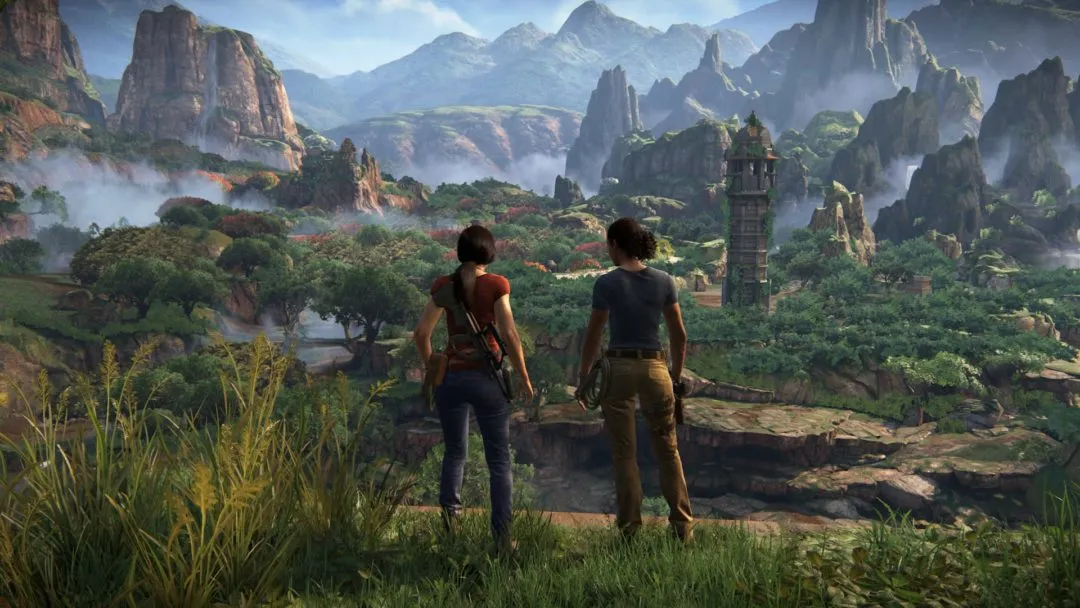This feature about Naughty Dog’s Uncharted: The Lost Legacy and its real-life inspirations was originally published in March of this year.
A steam whistle blares out across the jungle. A tiny blue locomotive labors uphill, heaving three packed carriages into the mountains. As it climbs, the clouds creep in closer and closer, filling the gaps in the forest with a dense, milky white. Every once in a while, the train passes a sign that reads out the altitude: 1,000 meters, 1,500 meters, 2,000 meters. The steam train crawls onward, creaking over hundred-year-old rails, passing through dynamite-blasted tunnels and over rusting bridges.
This is the Nilgiri Mountain Railway, taking its once-a-day, four-hour journey up towards the tea plantations of Ooty, India. At 2,240 meters up, the train is greeted with the landscape of the Western Ghats. The view is evocative of Kipling’s literature, old adventure serials, or Indiana Jones. It’s no surprise that this place would wind up being the setting of Naughty Dog’s 2017 action-adventure title, Uncharted: The Lost Legacy.
Lost Legacy follows the pursuits of archaeologist and thief Chloe Frazer as she attempts to uncover the precious Tusk of Ganesh from the lost city of Halebidu in the jungles of South India.
“Yeah, I’ve been to Halebidu. It doesn’t have trees.”
That’s Archana. She is a Tamilian who took an interest in Lost Legacy after she overheard her own language in some promotional footage. It was the first time she had ever heard Tamil spoken in a video game, so I sat her down with a copy and started taking notes on her experience.
“I went to Halebidu as a kid on a school trip,” she said. “It doesn’t have all these trees though. Also, the characters pronounce Halebidu wrong.”
Even though the game is set in the Western Ghats, it takes some liberties with the geography. The lush forests around Ooty, like those seen in the game, are a five-hour drive away from the more rocky Halebidu, which is clearly not lost, nor does it have — astonishingly — ginormous clockwork statues. Whilst none of that is exactly surprising, Archana was impressed by what the game developers managed to include. She wandered around the game’s opening location, a non-specified South Indian city, and took in the details and the background characters.
“That woman there is haggling, trying to give 35 rupees instead of 45,” she said, translating the Tamil dialogue of a pedestrian.
In the crowds are men wearing location-appropriate lungis (plaid sarongs). Lost Legacy also makes detailed references to Hindu mythology and the Hoysala Empire, though said Empire is more associated with the neighboring state Karnataka than Tamil Nadu. A few minutes later, Archana chides Frazer for the risk she is taking as a woman wandering the streets alone after dark. Moments later, Frazer is grabbed by some rowdies at a checkpoint.
“See?”
Naughty Dog has gone to a lot of trouble recreating a South Indian setting, building in far more detail than its intended Western audience is likely to notice. This is uncommon; when Western-made games or movies depict India, they practically always go with a Disneyland version of the Northern states. It is far easier for creators to find Hindi speakers and to fall back on old stereotypes found in Kipling and Indiana Jones. Uncharted surpasses its inspirations in terms of verisimilitude, even if it quickly starts having to make concessions for the sake of creating a compelling narrative.
For instance, 10 minutes into the game you watch the Indian Air Force bomb the rebel-occupied city. The game’s villains are a rebel force who are in the midst of a civil war with the Indian government. This is incongruous if you are at all familiar with the region, but it could seem entirely plausible to an uninformed player. The sad fact is that most people playing the game have only heard references to Tamil people from stories about the Tamil Tigers, a former terrorist organization local to Sri Lanka. With that being their only frame of reference, a war in Tamil Nadu or Karnataka sounds about right.
Fiction often exploits the player’s presumed ignorance, with creators filling in the gaps of knowledge with whatever is necessary to tell an engaging story. It’s a useful tool for writers and one of the reasons “exotic” locations are popular, but there is always the risk of misinforming the audience and playing into unfortunate stereotypes. The tendency to color in these gaps with fabricated elements represents a dilemma for creative teams. On one hand, there is an expectation to create a plausible, respectful representation of a setting.
On the other, there is an expectation to tell an engaging adventure story with exciting gameplay. Reality isn’t condensed excitement, nor is it ethically straightforward. At some point, a creative team has to make some kind of concession to fantasy. It is very easy to take that too far though.

Take the Far Cry franchise. Far Cry 2 through 4 are set in purely fictional locations, but they borrow cultural elements from real places. Far Cry 3’s Rook Islands are festooned with Japanese World War II ruins, the locals speak Malay, and the native Rakyat people are decorated with Maori Tā moko facial tattoos. It’s a confused kitchen sink of ethnic signifiers and using real world cultures as flavouring for the setting associates these groups with violent tribes and psychopathic pirates.
The series’s core audience didn’t really start to notice these incongruities until Far Cry 5, which is set in rural Montana. Players could suspend disbelief while occupying a Melakan/Polynesian island or Far Cry 4’s pseudo-Himalayas, but open warfare in the familiar U.S. broke their immersion. All of Far Cry‘s scenarios are equally unrealistic, but only with Far Cry 5 did the game’s core market experience what it feels like to see your local culture compromised for the sake of creating an adventure story.
None of this is to say there is something inherently wrong with presenting real nations in video games. But the nature of the medium means it’s far more resource-intensive for a game to recreate a location than a book or TV show. If you look back over earlier games, creators tended to take easy shortcuts that made the best of limited time and processing power. Resident Evil 4 was first shown to me by a Basque person, who explained that while the game was set in Spain, the Mexican voice actors made no effort to alter their own accents when reciting the Spanish-language dialogue.
“It’s nice to see Tamil people in a Western-made game,” she said. “We never get that screen time in movies and the like, nor do Indians normally get to be the hero, and they get enough right that I enjoy what I’m seeing.”
The average English- or Japanese-speaking player isn’t expected to notice, but for a Spanish person it’s painfully obvious that the developers weren’t all that bothered with things like authenticity. Similarly, the first Uncharted game, Drake’s Fortune, doesn’t have any scenes to establish a Latin American locale. It simply deposits the player in empty jungles and ruins. Studios and games have grown in size and scale during the last decade. While we tend to talk about design evolution in terms of graphics and engine capability, we devote a lot less to the growing cultural fidelity, even though there have been huge strides made in providing a more authentic experience.
Archana’s impressions of Lost Legacy were largely positive. She might smirk at the odd bit of game design that can’t be explained away as part of the magical realism of the adventure tale, but she appreciated the effort.
“It’s nice to see Tamil people in a Western-made game,” she said. “We never get that screen time in movies and the like, nor do Indians normally get to be the hero, and they get enough right that I enjoy what I’m seeing.”

There is one other way to create a local authenticity in games: when locals make the games themselves. The most impressive example of this was summarized by my Polish friend, Bernard.
“Poland didn’t get represented in games,” he said. “In the end we ended up representing ourselves. We had some small studios for a while, things were quiet, but then we had The Witcher and CD Projekt, which of course are huge right now. A big part to The Witcher‘s success is how different and unusual the fantasy is presented, but to Polish and Slavic people these are just versions of our local fairy stories and folklore. Beyond that, we have Observer, which is a game jointly made between a Polish team and an American publisher. So now we have collaborations too.”
All the complications I mentioned before go away when a country has its own studios that can represent themselves to the world. As development teams grow in size and spread to new studios across the globe, their teams gain more voices and perspectives. While there traditionally hasn’t been as wide an audience for video games in many parts of the world, things are changing as places like India have growing disposable income for entertainment. The way things are progressing, it looks like studios will be all too happy to satiate that appetite for authentic stories.






Published: Aug 8, 2019 10:00 am